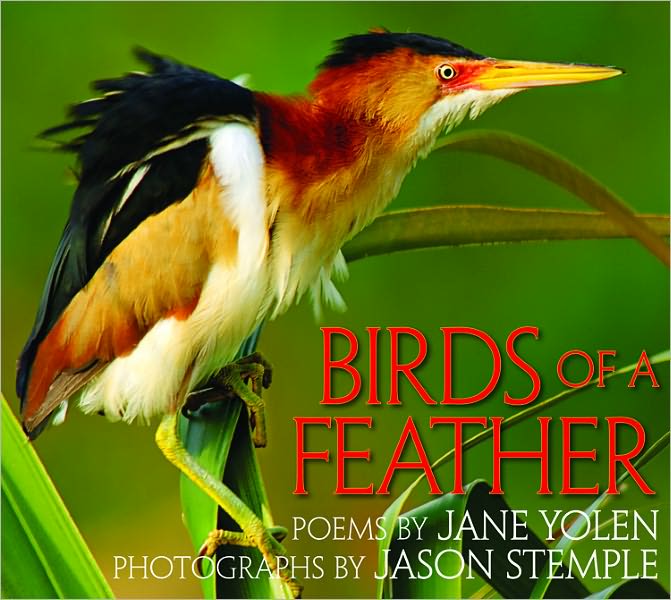
 Birds often alight for only a moment, and it's difficult to get a close look at them without startling them aloft. Here Jane Yolen uses the poetic form and Jason Stemple the camera lens to capture a feathered creature's momentary pause--surveying the land from a tree branch, coasting in flight, strolling on a seashore--and allow us to examine them closely and consider them at length. Many of the birds in these 14 poems will be new to children (the cedar waxing, the marbled godwit), but they will see even familiar birds anew.
Birds often alight for only a moment, and it's difficult to get a close look at them without startling them aloft. Here Jane Yolen uses the poetic form and Jason Stemple the camera lens to capture a feathered creature's momentary pause--surveying the land from a tree branch, coasting in flight, strolling on a seashore--and allow us to examine them closely and consider them at length. Many of the birds in these 14 poems will be new to children (the cedar waxing, the marbled godwit), but they will see even familiar birds anew.
Yolen combines canny observations--often with a comic touch--along with characteristics unique to each species. A black-capped chickadee becomes "plump little fellow/ with your black cap on," and the poet emphasizes its hoarding instincts: "I will leave some seeds for you-free-free./ You can hide them all from me-me-me/ With your black cap on." She describes a cluster of Oystercatchers as "a bunch of windup toys,/ Oystercatchers on parade,/ Unafraid,/ Strutting out with a kleeping noise," while the photograph substantiates these claims. Their pink legs precisely aligned, the oystercatchers seem to strut in a "stiff parade." Some of the bird facts will come as a surprise. The eastern kingbird may "look like... a modest minister," but doubles as "a spy, a guerilla/ a ninja of the air," for it will attack hawks and crows that come anywhere near its nest. Brief fact boxes explain the informational references without detracting from the poetry. And speaking of crows, "a mob of crows" (in attack behavior called "mobbing") will take on a bald eagle: "Democracy in beak and claw/ finds regal eagle's fatal flaw./ And is that legal? I don't know./ You'll have to ask a mobster crow." A standout photograph depicts a hooded merganser, an odd-looking diving duck, floating peacefully in the water. Stemple angled the camera in such a way that he trapped flecks of golden light in the ripples of the water, which draw out the birds mottled golden feathers and play up the "Navy stripes on [its] shoulder."
The mother-son team takes us along as guests on their birdwatching tour. They put into words and images a sense of wonder, but never take themselves too seriously. "Haiku for a Cool Kingfisher" goes like this: "Hey, girl, fish lover,/ Sitting on the dead gray tree,/ Love the blue Mohawk." Stemple's astounding photograph emphasizes its smoky blue "Mohawk" because of the tree carcass on which it perches. The tip of the wood bows out in a downward arc that beautifully plays up the shape of the kingfisher's tail feathers; the rust-colored tones where the arc connects with the tree's vertical thrust mimics the metallic feathers of the bird's belly. The blocks of text in the layout of the spread precisely match the bird's dominant smoky blue tones, including the Mohawk. The design of the book sets up tantalizing contrasts, as with the royal tern. The raucous tone of the poem, "Terns Galore," created through a cascade of synonyms, clashes enticingly with the serene feeling of the photograph, in which a lone tern coasts over a "packed colon[y]" of its peers. "At the seaside, terns galore,/ One tern, one tern, one tern more./ I tern. You tern./ My turn to fly, tern." It reads almost like a tongue twister, especially in the concluding lines: "Why, tern, why turn?/ Turning terns are all returning,/ There upon the shore." Then, in the endpapers, we see a ghosted image of the entire tern colony in flight. Breathtaking.--Jennifer M. Brown

